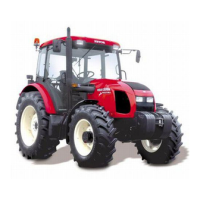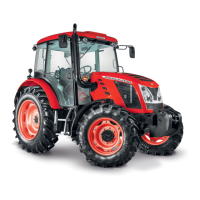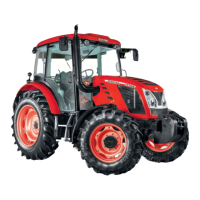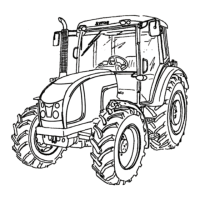Do you have a question about the Zetor Proxima Plus 85 and is the answer not in the manual?
| Engine Power | 85 HP |
|---|---|
| Max Speed | 30 km/h |
| Engine | Zetor |
| Transmission | Mechanical |
| Fuel Tank Capacity | 90 liters |
Covers operational requirements and general safety principles for tractor use.
Guidelines on appropriate attire and personal protective equipment for safe operation.
Instructions and warnings related to safely starting the tractor engine.
Essential safety advice for operating the tractor on various terrains and slopes.
Safety rules for transporting vehicles and operating the tractor with implements.
Procedures for safely exiting and parking the tractor.
Safety precautions related to the tractor's electrical system and battery.
Checking fuel system connections and the fuel tank for leaks.
Procedure for checking engine oil level and lubrication system connections.
Ensuring tightness of cooling system connections and checking coolant level.
Checking fluid brakes, clutch fluid, and brake fluid level in the expansion tank.
Checking oil level and condition of hoses in the hydrostatic steering system.
Checking tyre pressure and tightening wheel screws.
Procedure for maintaining the air cleaner based on the clogging indicator.
Checking and cleaning air filters for the cabin ventilation system.
Guidance on safe entry/exit and features of the tractor's safety cabin.
Instructions for operating the rear and side windows and tiltable cover.
Information on passenger seat, tool box, rear panel, and window mirrors.
Details on washer nozzle, tank, and activation for windscreen cleaning.
Instructions for adjusting seat cushioning, longitudinal, and vertical positions.
Information on the active carbon air filter for pesticide spraying.
Overview of heating control panel, fan control, and A/C switch.
Explanation of air circulation control for cabin climate management.
Description of instruments and indicator lights on the tractor's dashboard.
Explanation of indicators and pushbuttons on the digital dashboard display.
Identification and function of various switches, levers, and the ignition box.
Details on pedals and levers for gear shifting and reversing.
Instructions for switching on and shifting speeds of the rear output shaft.
Pre-start checks for braking and gear lever position.
Step-by-step guide for starting the tractor engine safely.
Interpreting fault indicators in the heating system during engine operation.
Recommended procedure for warming up the engine after starting.
Guidance on shifting gears, reversing, and using road/reduced gears.
Safety advice for driving the tractor on inclines.
Operation and use of the differential lock and front driving axle.
Information on foot brakes, trailer brakes, and air pressure warnings.
Procedures for stopping the tractor using the hand brake and stopping the engine.
Key guidelines for running-in a new tractor for the first 100 operating hours.
Specific tasks and checks during the initial 100 hours of tractor operation.
Recommended operating values and procedures after the initial running-in period.
Usage instructions for the front hook when towing or extricating the tractor.
Details on multi-level quick-adjustable hitches and their height adjustment.
Description of modular hitch systems for trailers and semi-trailers.
Guidelines for using the towing bar, including height adjustment.
Procedures for coupling and uncoupling single-axle trailers.
Requirements for coupling tractors with trailers or semi-trailers.
Table of maximum permitted vertical static loadings for various hitch types.
Safety and operational guidelines for using the tractor's output shafts.
Control and engagement procedures for front and rear output shafts.
Shifting speeds for dependent and independent rear output shafts.
Specifications for the front output shaft, including rotation direction.
Table specifying maximum power transfer capabilities for output shafts.
Safety recommendations for driving machines with high inertial masses.
Information on the hydraulic pump and its delivered volume.
Procedure for replacing the hydraulic oil cleaner cartridge.
Overview of levers controlling internal and external hydraulic circuits.
Details on levers for internal circuit regulation and speed of response.
Explanation of the four positions of the external circuit control lever.
Instructions for controlling single-acting hydraulic cylinders.
Instructions for controlling double-acting hydraulic cylinders.
Description of the additional hydraulic distributor and its sections.
Using external controls for rear hydraulic arms and safety precautions.
Design and categories of the rear three-point hitch system.
Safety principles when working with implements attached to the three-point hitch.
Procedures for adjusting the height of lifting pull rods.
Function and adjustment of limiting pull rods for side swing control.
Adjusting the upper pull rod length and selecting bracket holes.
Using lower pull bars with extensible terminals for implement coupling.
Design and control of the front three-point hitch system.
Working and transport positions for the front three-point hitch.
Procedure for changing front wheel tread by adjusting rim and disk positions.
Setting stops on the front driving axle after changing wheel tread.
Measurement and adjustment of front wheels toe-in.
Adjusting toe-in for tractors with front driving axles and hydrostatic steering.
Adjusting mudguards on the front driving axle for different wheel treads.
Procedure for adjusting the tread of rear wheels.
Specifications for weights installed in front of the bonnet mask.
Details on combinations and weights for the front three-point hitch.
Weight combinations for mounting on rear wheels.
Information on valves for filling tyres with fluid.
Step-by-step guide for filling and discharging fluid from tyres.
Composition and preparation of non-freezing solutions for tyre filling.
Nominal voltage, battery, alternator, starter, and V-belt specifications.
Important notes on battery connection and starter manipulation.
Guidelines for cleaning, fixing, and maintaining the tractor battery.
Precautions and maintenance procedures for the tractor's alternator.
Diagram and description of fuses in the fuse box and their protected systems.
Checking and adjusting tractor headlamps for correct beam alignment.
Checking adjustment of lights mounted on the tractor's cabin roof.
Table detailing lamp locations, voltage, power, socket type, and notes.
Tasks to perform daily before and after starting the engine.
Lubrication tasks to be performed every 50 hours of tractor operation.
Checks and cleaning tasks required every 100 operating hours.
Maintenance operations to be carried out at 500-hour intervals.
Schedule for replacing engine oil, filters, coolant, and brake fluid.
Recommended oils for engines, front output shafts, and transmissions.
Specifications and notes for tractor hydraulic brake fluids.
Lubrication points for the front driving axle and trailer suspension.
Procedures for initial run and maintenance after tractor unit overhaul.
Instructions for safely opening and closing the tractor's front bonnet.
Procedures for checking engine oil level and draining engine oil.
Steps for replacing the full-flow engine oil cleaner.
Procedure for bleeding the fuel system after filter replacement.
Maintaining the dry air cleaner and understanding the clogging indicator.
Procedure for regenerating the main air cleaner cartridge.
Daily checks for oil level in the hydrostatic steering tank.
Steps for bleeding the hydrostatic steering hydraulic circuit.
Procedure for draining and refilling the tractor's cooling system.
Checking and replacing oil in gearbox, axle drive, and rear axle portals.
Lubrication and filling points for the front driving axle components.
Cleaning procedures for heating system filters located outside the cabin.
Importance and procedure for cleaning the A/C condenser.
Checking tyre condition, inflation, and procedures for laying up the tractor.
Procedure for adjusting V-belt tension for the engine and A/C compressor.
Instructions for retightening the engine cylinder head on a cold engine.
Correct valve play for suction and exhaust valves on a cold engine.
General order and procedure for bleeding the tractor's brake systems.
Procedure for bleeding the main brake valve for trailers.
Steps for bleeding the brakes of the tractor's rear wheels.
Procedure for bleeding the brake system of the front driving axle.
Steps for bleeding the hydraulic brakes of the trailer.
Adjusting the tractor's foot and hand brakes.
Adjusting the play between the brake pedal and main brake valve piston.
Information regarding clutch pedal play adjustment, which is manufacturer-set.
Procedure for bleeding the clutch hydraulic circuit.
Adjusting the hitch for single-axle trailers.
Procedure for recalibrating the digital dashboard travel speed sensor.
Table of key dimensions of the tractor, including contour lengths and heights.
Technical details of the tractor engines, including power, torque, and oil pressure.
Maximum permitted loading for front and rear axles based on travel speed.
Table showing loading capacity of front tyres based on travel speed and tyre size.
Table of rear tyre loading capacity based on travel speed and tyre size.
Permitted combinations of front and rear wheels for tractors.
Power output specifications for different tractor models and engine states.
Forward and backward travel speeds for 30 km/h tractor models.
Forward and backward travel speeds for 40 km/h tractor models.
Speeds of rear and front independent output shafts relative to engine speed.
Specifications for outer contour and track wheeling diameters.











